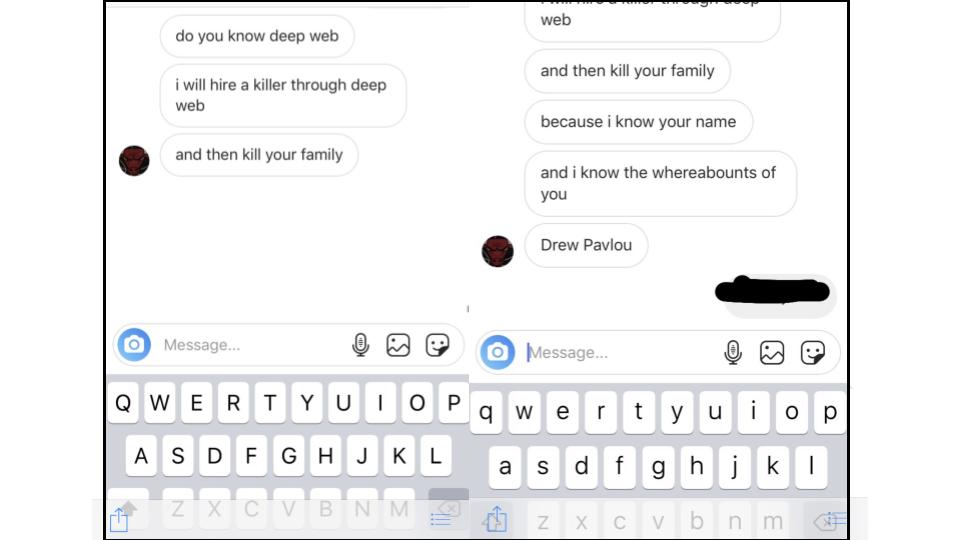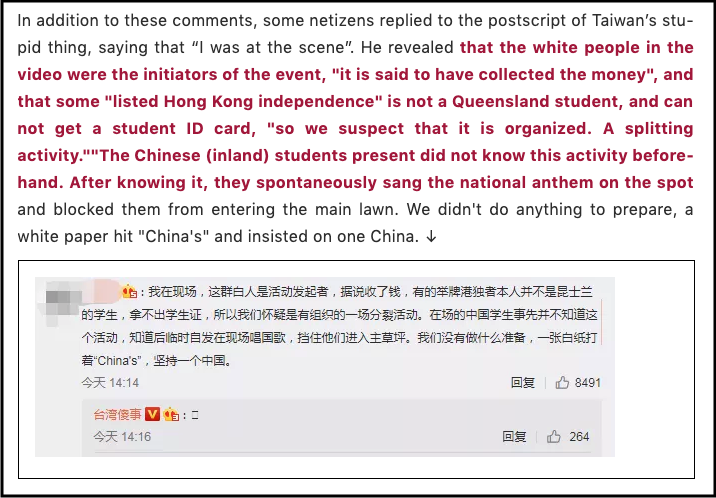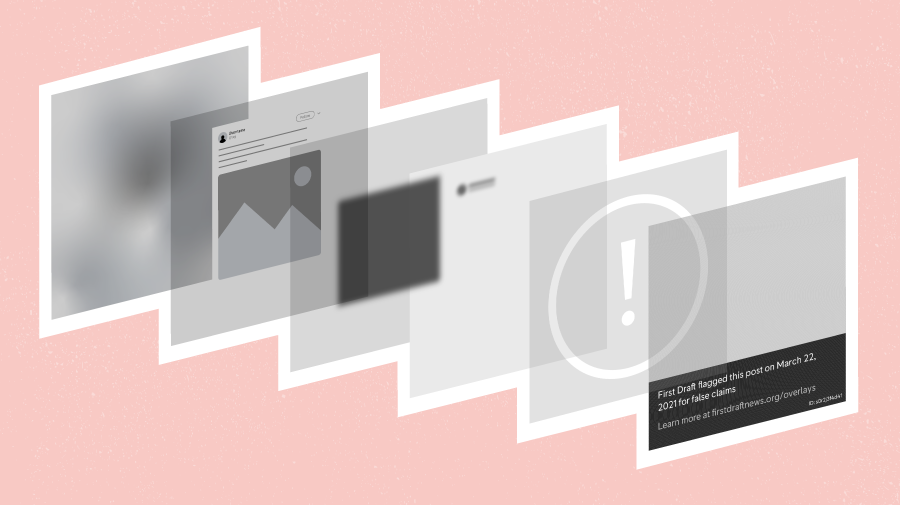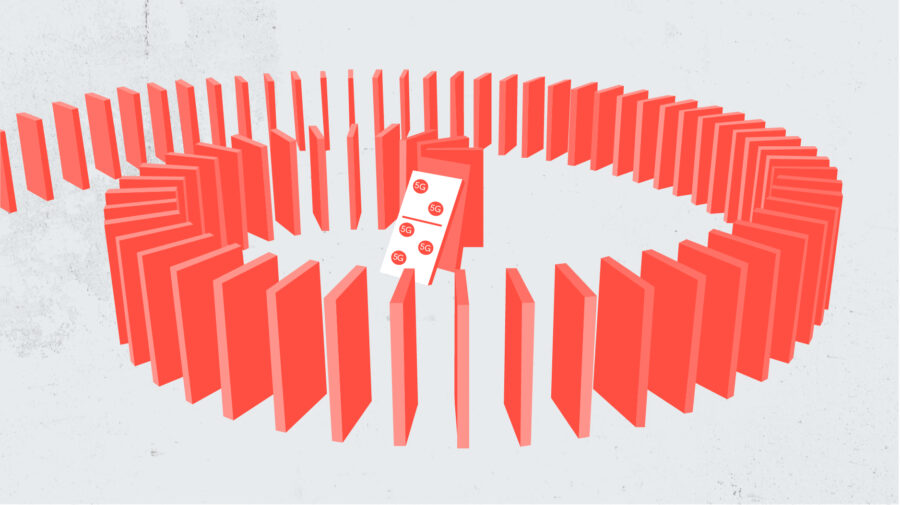SYDNEY – The anti-government protests in Hong Kong have made international headlines in the weeks since they began, as violent clashes between police and activists are beamed around the world.
But as is so often the case with instances of social conflict now, bitterness and rancour spills over onto the borderless web and back into the ‘real world’.
While police and protesters battle on the streets, in train stations and now Hong Kong’s airport, tensions have flared among international students on university campuses abroad, fuelled by arguments and intimidation on social media. It has all the hallmarks of what can be described as information disorder: manipulated photos, out of context videos, international conspiracy theories and doxxing.
The loudest reverberations outside Hong Kong were heard during rallies in late July at the University of Queensland (UQ) in Brisbane, where pro-democracy protests added to existing tensions around Beijing’s spending and influence on campus.
The protests began in support of Hong Kong students fighting a now suspended extradition bill with China, but later brought in a range of grievances against the Chinese government, including the persecution of the spiritual practice Falun Gong, human rights in Tibet, and camps in the western Xinjiang region where Uighur Muslims are sent for ‘re-education’.
Events in Brisbane became heated after pro-China students arrived in opposition to the initial rallies, voicing their opinions, playing the Chinese national anthem and, in some cases, pulling down signs.
Chinese students clash with pro-Hong Kong protesters at UQ after peaceful sit in #uq #hongkong #china pic.twitter.com/3hvRRyAHEI
— Nilsson Jones (@nilssonjones_) July 24, 2019
Since then, more protests have led to further clashes and hostility on campus. Protest supporters erected a ‘Lennon Wall’ for students to post messages of support only for masked men to be caught on CCTV tearing it down at night.
Pro-democracy activist Joshua Wong, labelled the ‘poster boy for Hong Kong protests’ after being jailed for his role while a teenager in 2014’s Umbrella Movement, said pro-democracy supporters in Hong Kong were angry at seeing the clashes in Australia.
“Those Chinese people in Australia, they enjoy democracy in Australia but they just attack Hong Kong people fighting for democracy — it’s insane,” he told First Draft.
Elsewhere, rallies and protests in support of Hong Kong protesters have taken place at New South Wales’ state library in Sydney, Melbourne’s Parliament House, as well as in Adelaide and Perth.
In New Zealand, the University of Auckland launched an official investigation after one man appeared to barge a female protester during a heated exchange on campus, leaving her lying on the ground. Since then, protest supporters have been the targets of online harassment, “mostly from mainland Chinese internet trolls”, according to the South China Morning Post (SCMP). One administrator for the Facebook Page ‘New Zealand Hong Konger’ reportedly shared screenshots with the SCMP of messages containing threats of violence against reporters.
The polarisation of the online conversation has provided a breeding ground for misinformation, spreading harassment and hate speech abroad as the rumours and arguments multiply.
Drew Pavlou, a 20-year-old student at UQ and one of the main organisers of pro-democracy protests in Brisbane who has appeared on national television to defend his cause, wrote in a Facebook post that “there are lies spreading about me on Chinese social media”, including anti-Chinese and anti-immigration statements.
“In the days after the protest, I received dozens of death threats, and my image was circulated” on Chinese social media, he told the Washington Post. “I have feared for my life.”
Pavlou shared screenshots of the threats with First Draft, which included videos of bodies in what appeared to be war zones and the message “you can… be like that guy”.
Another message threatened to “hire a killer through deep web and then kill [Pavlou’s] family”.

Screenshots Drew Pavlou shared with First Draft show threats made against him and his family. First Draft chose to remove the name of the account which sent the messages from the screenshot. Pavlou censored his reply to the threat. Screenshot/Drew Pavlou.
He told First Draft he is trying to take regular social media breaks.
Wong, now 22, said these are the same online tactics of harassment and fear which were used against him in the past.
“People [in Hong Kong] have no trust in government and, at the same time, no trust in social media,” said Wong, and this makes the online world a fertile ground for misinformation about conspiracy theories, a classic “strategy of the pro-Beijing camp,” he added.
Foreign conspiracy theories are also never far from the arguments, as was the case in 2014 when Chinese media accused the US of instigating the Occupy Central protests in Hong Kong. The theme continues now regarding the current situation in Hong Kong, but has also reached Australia.
The threats and accusations made against Wong, including claims he is a CIA agent and trained as a marine, “just point out how the soft power of China expands, not only in Hong Kong but also Australia”, he said. Pavlou claimed he had also been accused of working for the CIA.
Nilsson Jones, a journalism and political science student at the University of Queensland, witnessed the July 24th protest by chance, and since then has been writing about the situation as a student reporter, speaking to both sides. He has followed the reaction on social media and become an unwitting victim in the process.
“I received death threats, and had abusive messages in Chinese saying ‘Hong Kong is none of your business, stay away from campus if you know what’s good’,” Jones told First Draft, adding that a UQ student from Hong Kong had been doxxed in the wake of the protests.
“They had their driver’s licence, marriage certificate, student ID and other identifying information published on Chinese social media site Weibo,” he said.
For the THIRD night in a row, groups have come in the dead of night and torn down the Lennon Wall made from HK students. The past two nights the groups were masked, tonight we can see the faces of three supposed students speaking with security. #uqprotests #lennonwall #hongkong pic.twitter.com/ZrOv0j79M5
— Nilsson Jones (@nilssonjones_) August 8, 2019
However, Jones noted in the immediate fallout from the first protest there were some instances of anti-China comments on a Facebook group for past and present UQ students known as ‘UQ StalkerSpace’.
“Primarily it was taking the mickey out of Chinese students wanting to defend the CCP [Chinese Communist Party], saying nothing happened today, this is none of Australia’s business,” he said.
“The admins were quick to [remove] posts and comments that were undeniably based on race.”
A Chinese YouTube user who claimed to be a UQ student sought to explain the grievances of the pro-China protesters, arguing in his video that the situation in Hong Kong should not concern westerners.
Videos of the protests in Brisbane had been “deliberately manipulated and edited” and “maliciously provoked by foreign forces”, according to the video’s subtitles. Protesters were not students but hired stooges paid to oppose China, the user claimed, and he singled out Pavlou and a Chinese exile present at the protests for their role. The video has been viewed nearly 20,000 times, according to YouTube.
The same theme played out in arguments on Twitter and the UQ protests gained the attention of WeChat users in China. University of Hong Kong Researcher Ann Choy said posts on WeChat have been making a variety of accusations against the protest organisers.
“One netizen commented that she was there at the scene and said one of the ‘white people’ in the video was the organiser and received money,” Choy said.

A translated article posted to WeChat, a favoured social network in mainland China, alludes to money changing hands at the protest in Brisbane. Screenshot/First Draft.
Both Pavlou and Jones denied receiving or witnessing any payments during the protests.
Eric Cheung, a freelance journalist covering the protests in Hong Kong who also reported from the Occupy Central movement in 2014, said such claims and counter claims are nothing new.
“The pro-Beijing camp has always accused the Americans of giving out money to protesters in the movement without giving any evidence,” he said. “On the other hand, protesters [in Hong Kong] have constantly spread false rumours about police movements.”
Cheung said while journalists should work to actively call out falsehoods, he has identified a worrying trend which has only added to the online confusion.
“What is ironic is that some netizens have been abusing the words ‘fact-checked’ when they post information online. They often claim that they have already verified the information, without disclosing how.”
Among the conflicting narratives and disinformation, one thing that is clear is that there is little helpful dialogue at present on social media.
Dr. Masato Kajimoto, assistant professor in the journalism school at the University of Hong Kong, said this is because of the way people can use social media to find and build communities that share their political views or ideologies beyond what would normally occur offline within geographical and social boundaries.
“In the digital community, your views are backed by many like-minded users; venomously dissing opposing ideas,” Kajimoto said.
Evidence of this “geographical” spillover was seen in the online aftermath of the Australian protests.
“Counter arguments are often applauded because people with such views are not in your community, unlike the real-world communities like your neighbourhoods, schools and workplaces,” Kajimoto said.
And this, he added, further perpetuates a cycle of polarisation in public conversations.
An explanation for the polarisation can come from what psychologists describe as ‘cognitive dissonance’.
“When we encounter information that is not in line with our existing views and our brain tries to make sense of it somehow… research suggests that our line of reasoning is often self-serving, which influences the way we interpret the information at hand,” Kajimoto said.
The images of tear gas in the streets and riot police with batons raised high charging unarmed protesters “would have been unimaginable for anyone living in Hong Kong just a couple of months ago” Kajimoto said, and this creates dissonance “because it conflicts with the image of safe, civilised society [which] people had about the city.”
The mainland Chinese trolls are out in full force after last night’s #HongKongProtests. I posted a picture on IG & it now has 200+ comments, almost all in simplified Chinese, and with a lot of Chinese flag emojis. https://t.co/Lm7wIID5rX pic.twitter.com/6ytqTO4ZzZ
— Laurel Chor (@laurelchor) August 14, 2019
“To make sense of it, protesters and their supporters see brutal, excessive use of unnecessary force and blame the police,” he explained, while pro-China supporters see actions appropriate to uphold the rule of law deployed against rioters and criminals.
“Both sides tend to use the same logical justification of the physical confrontation to resolve the ‘dissonance’ in their mind – that is, ‘we have been left no choice by the other side’ – and that is one of the reasons why polarisation is intensifying under the current, tense situation, in my view.”
But if people were better educated in media literacy and more aware of their natural propensity for cognitive dissonance would this help the online/offline conversations – or is it too far gone?
“On social media, commentaries about news stories are often very spiteful towards opposing views,” Kajimoto said, adding that he can’t see an improvement occurring in the tone of dialogue or level of polarisation any time soon.
“It would be really hard at this point for the two sides of the political spectrum to understand each other, even though they are aware of the cognitive limitation we all have,” he said.






